153 lines
10 KiB
Markdown
153 lines
10 KiB
Markdown
对于使用过 Flutter 的开发来说,应该对在 Flutter 混合开发中,通过 `PlatformView` 接入原生控件的方式并不陌生,而如果你是从 Flutter 1.20 之前就开始使用 Flutter ,那么应该对于 Android 上 `PlatformView` 的各种体验问题有过深刻的体会,比如:[ `WebView` 里弹出键盘的问题](https://juejin.cn/post/6858473695939084295)。
|
||
|
||
> ⚠️注意:文末有惊喜
|
||
|
||
## 从一个问题开始
|
||
|
||
恰巧最近一位朋友在 Flutter 2.10.1 上使用 `webview_flutter` 和 `flutter_pdfview` 测试时出现了如下的问题:
|
||
|
||
```
|
||
attachToContext: GLConsumer is already attached to a context at
|
||
android.graphics.SurfaceTexture.attachToGLContext(SurfaceTexture.java:289)
|
||
```
|
||
|
||
**所以借着这个问题来给大家科普下 Flutter 里 `PlatformView` 实现的变迁和未来调整**,首先这个问题的起因是因为:
|
||
|
||
> virtual displayes 和 hybrid composition 两种 `PlatformView `实现混合使用。
|
||
|
||
因为从 Flutter 2.10 开始,官方的 Plugin 如 `webview_flutter` 默都是使用 *hybrid composition* 的实现,而第三方的 `flutter_pdfview` 目前还是使用以前的 *virtual display* ,这就出现了两种 `PlatformView` 实现同时出现的情况。
|
||
|
||
当然,官方在 2.10.2 版本的 [#31390 ](https://github.com/flutter/engine/pull/31390) 上修复了这个问题, 问题的原因在于:**当 rasterizer 任务运行不同的线程时,`GrContext ` 会被重新创建,从而导致 `texture` 变成没有初始化的状态,进而重复调用 `attachToGLContext` 导致崩溃**。
|
||
|
||
> 所以后续官方修复这个问题,就是在 `attachToGLContext` 之前,如果 `texture` 已经 attach 过,就先调用 `detachFromGLContext` 进行释放,从而避免了初始化 context 的问题。
|
||
|
||
但是从问题上看,其实这个问题并不是 2.10 才会出现,而是只要在 `SurfaceTextureWrapper` 这个对象存在时 ,混合使用 *virtual displayes* 和 *hybrid composition* 就能引发这个 bug 。
|
||
|
||
> `SurfaceTextureWrapper` 是官方用于处理同步的问题,因为当 `SurfaceTexture` 被释放时,由于 `SurfaceTexture.release` 是在 platform 线程被调用,而 `attachToGLContext ` 是在 raster 线程被调用,不同线程调用时可能导致:**当 `attachToGLContext ` 被调用时 texture 已经被释放了,所以需要 `SurfaceTextureWrapper` 用于实现 Java 里同步锁的效果**。
|
||
|
||
所以如果在低版本不想升级,那么可以选择所有 Plugin 都使用 *virtual display* 模式或者 *hybrid composition* 模式,比如 `webview_flutter` 就提供了 `WebView.platform` 用于用户自由选择 `PlatformView` 的渲染模式。
|
||
|
||
**当然一般情况下我是更建议大家目前都使用 *hybrid composition* 模式,虽然两种模式都有潜在问题,但是相比起来目前 *virtual display* 带来的性能和键盘问题会让人更难以接受**。
|
||
|
||
|
||
|
||
## 区别和演进
|
||
|
||
其实在之前的 [《 Hybrid Composition 深度解析》](https://juejin.cn/post/6858473695939084295) 里就介绍过它们实现的区别,这里再结合上面的问题,从不一样的角度介绍下它们的实现差异和变迁。
|
||
|
||
### VirtualDisplay
|
||
|
||
一般 dart 代码里直接使用 `AndroidView ` 的我们就可以简单认为是使用 *virtual display* ,比如 [flutter_pdfview 1.2.2 版本 ](https://pub.flutter-io.cn/packages/flutter_pdfview) , 这种实现方式是 **通过将 `AndroidView` 需要渲染的内容绘制到 `VirtualDisplays` 实现中 ,然后在 `VirtualDisplay` 对应的内存里,绘制的画面就可以通过其 `Surface` 获取得到**。
|
||
|
||

|
||
|
||
> `VirtualDisplay` 类似于一个虚拟显示区域,需要结合 `DisplayManager` 一起调用,一般在副屏显示或者录屏场景下会用到。`VirtualDisplay` 会将虚拟显示区域的内容渲染在一个 `Surface`上。
|
||
|
||
如上图所示,**简单来说就是原生控件的内容被绘制到内存里,然后 Flutter Engine 通过相对应的 `textureId` 就可以获取到控件的渲染数据并显示出来**。
|
||
|
||
关于 *virtual display* 实现,如果你需要对应路径去调试问题,可以参看如下流程:
|
||
|
||
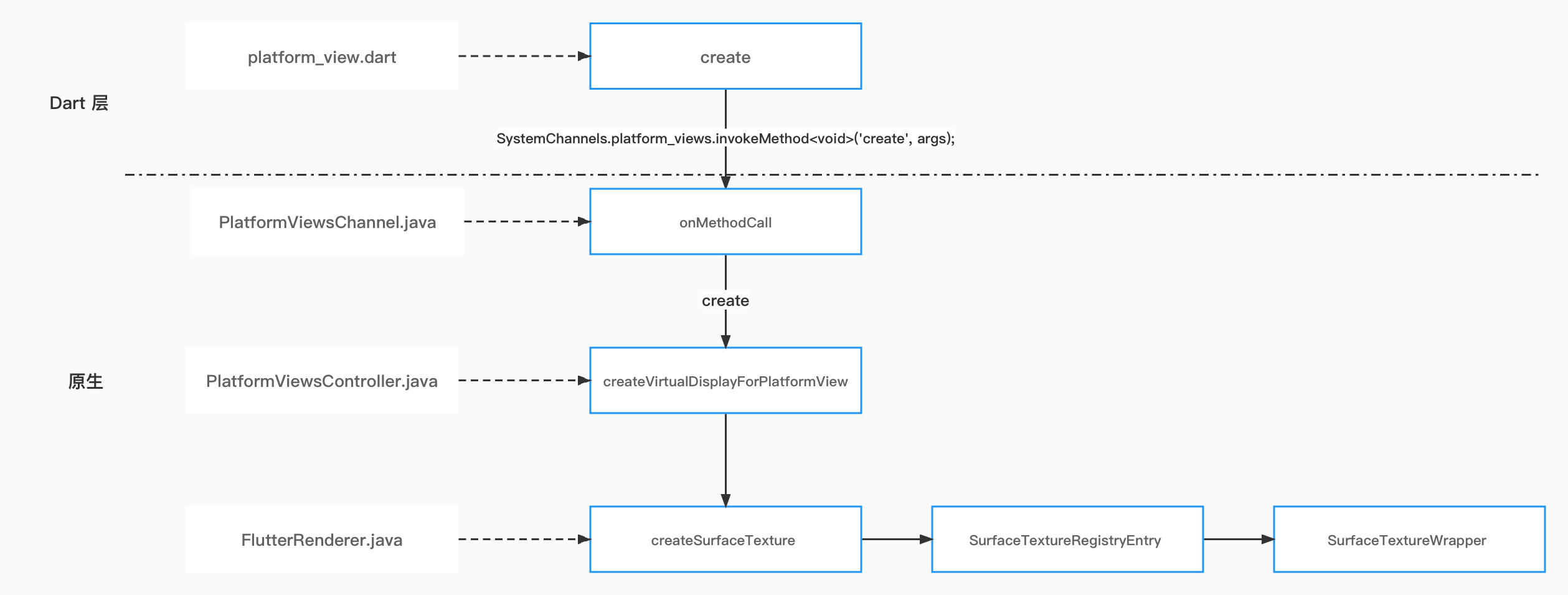
|
||
|
||
### HybridComposition
|
||
|
||
使用 *hybrid composition* 相对会比直接使用 `AndroidView` 在代码上更复杂一点, 需要使用到 [PlatformViewLink](https://link.juejin.cn/?target=https%3A%2F%2Fapi.flutter.dev%2Fflutter%2Fwidgets%2FPlatformViewLink-class.html)、 [AndroidViewSurface](https://link.juejin.cn/?target=https%3A%2F%2Fapi.flutter.dev%2Fflutter%2Fwidgets%2FAndroidViewSurface-class.html) 和 [PlatformViewsService](https://link.juejin.cn/?target=https%3A%2F%2Fapi.flutter.dev%2Fflutter%2Fservices%2FPlatformViewsService-class.html) 这三个对象,首先我们要创建一个 dart 控件:
|
||
|
||
- 通过 `PlatformViewLink` 的 `viewType` 注册了一个和原生层对应的注册名称,这和之前的 `PlatformView` 注册一样;
|
||
- 然后在 `surfaceFactory` 返回一个 `AndroidViewSurface` 用于处理绘制和接收触摸事件;
|
||
- 最后在 `onCreatePlatformView` 方法使用 `PlatformViewsService` 初始化 `AndroidViewSurface` 和初始化所需要的参数,同时通过 Engine 去触发原生层的显示。
|
||
|
||
```dart
|
||
Widget build(BuildContext context) {
|
||
// This is used in the platform side to register the view.
|
||
final String viewType = 'hybrid-view-type';
|
||
// Pass parameters to the platform side.
|
||
final Map<String, dynamic> creationParams = <String, dynamic>{};
|
||
|
||
return PlatformViewLink(
|
||
viewType: viewType,
|
||
surfaceFactory:
|
||
(BuildContext context, PlatformViewController controller) {
|
||
return AndroidViewSurface(
|
||
controller: controller,
|
||
gestureRecognizers: const <Factory<OneSequenceGestureRecognizer>>{},
|
||
hitTestBehavior: PlatformViewHitTestBehavior.opaque,
|
||
);
|
||
},
|
||
onCreatePlatformView: (PlatformViewCreationParams params) {
|
||
return PlatformViewsService.initSurfaceAndroidView(
|
||
id: params.id,
|
||
viewType: viewType,
|
||
layoutDirection: TextDirection.ltr,
|
||
creationParams: creationParams,
|
||
creationParamsCodec: StandardMessageCodec(),
|
||
)
|
||
..addOnPlatformViewCreatedListener(params.onPlatformViewCreated)
|
||
..create();
|
||
},
|
||
);
|
||
}
|
||
```
|
||
|
||
如果通过上面的问题来做个直观的对比,就会是如下图所示的变化:
|
||
|
||
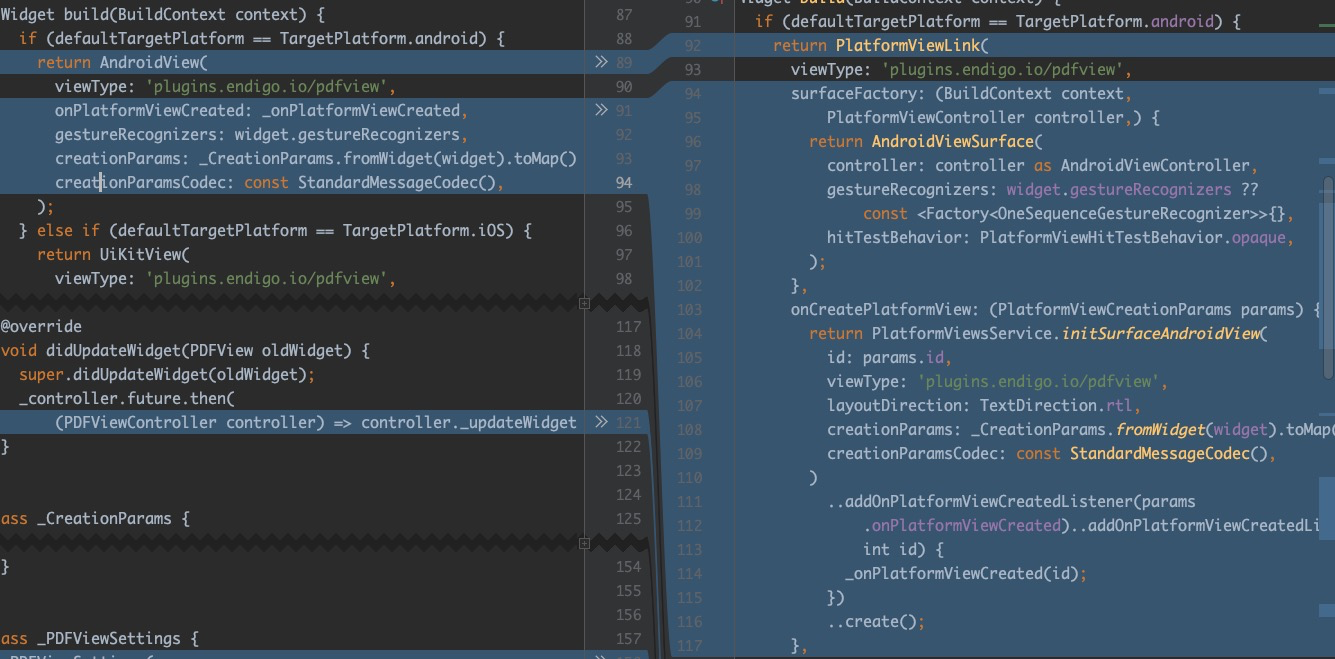
|
||
|
||
使用 *hybrid composition* 之后, **`PlatformView` 是通过 `FlutterMutatorView` 把原生控件 `addView` 到 `FlutterView` 上,然后再通过 `FlutterImageView` 的能力去实现图层的混合**,简单解释就是:
|
||
|
||
> Flutter 只直接通过原生的 `addView` 方法将 `PlatformView` 添加到 `FlutterView` ,这就不需要什么 `surface ` 渲染再去获取的开销,而当你还需要再 `PlatformView` 上渲染 Flutter 自己的 Widget 时,Flutter 就会通过再叠加一个 `FlutterImageView` 来承载这个 Widget 。
|
||
|
||
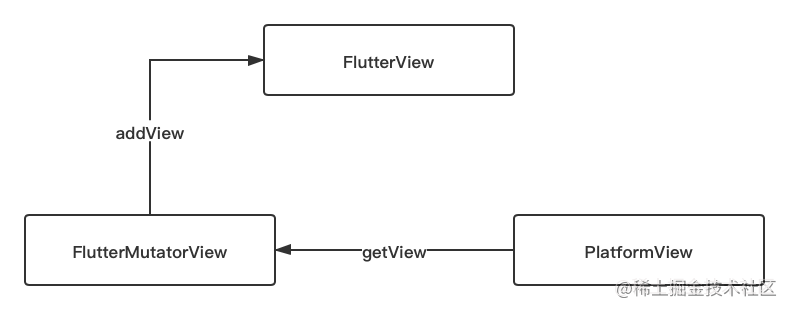
|
||
|
||
|
||
|
||
举个例子,如下图所示,其中:
|
||
|
||
- 两个灰色的 Re 是原生的 `TextView`;
|
||
|
||
- 蓝色、黄色、红色的是 Flutter 的 `Text` ;
|
||
|
||
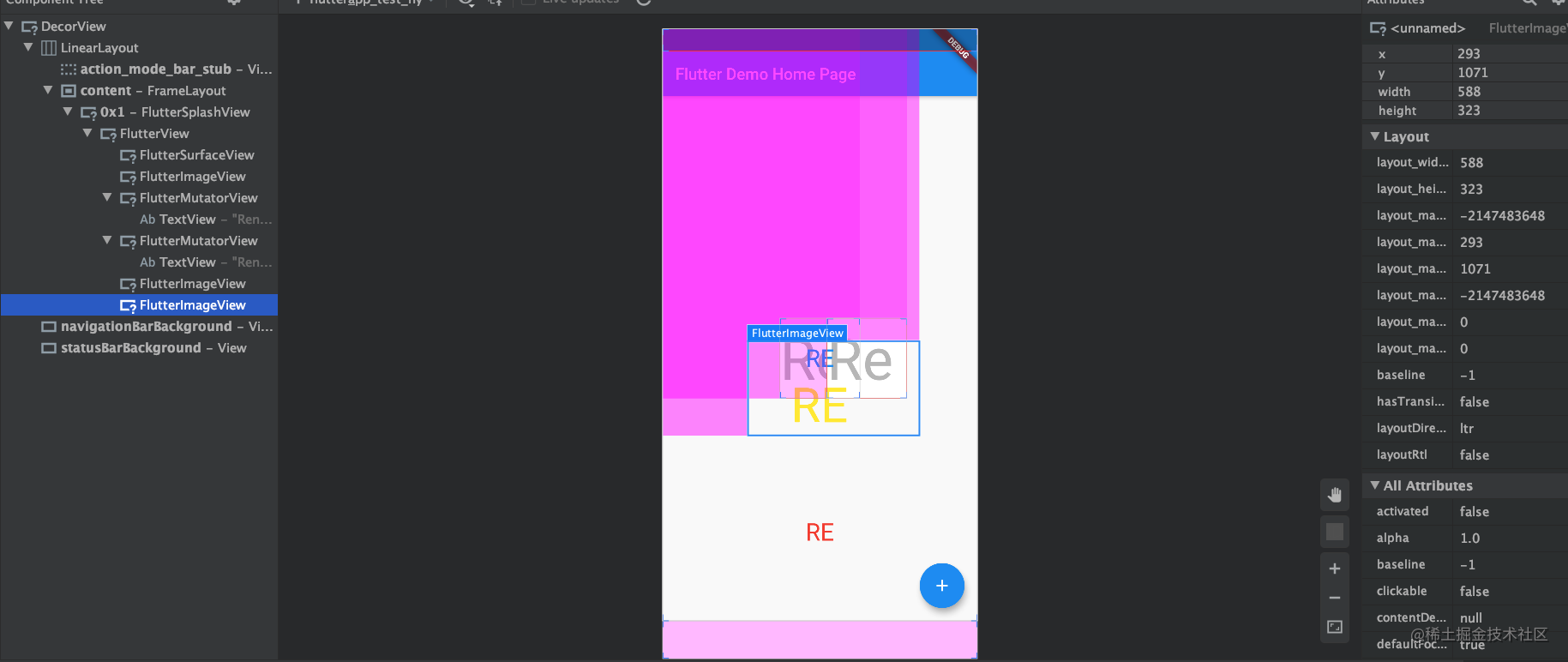
|
||
|
||
从渲染结果上可以看到:
|
||
|
||
- 灰色的原生 `TextView` 通过 `PlatformView` 直接就通过原生的 `addView` 方法添加到 `FlutterView` 上;
|
||
- 而红色的 Flutter 的 `Text` 控件因为和 `PlatformView `没交集,所以还是 Flutter 原本的渲染逻辑;
|
||
- 黄色和蓝色的 Flutter 控件,因为和 `PlatformView` 有交集,所以通过新的 `FlutterImageView` 做承载渲染。
|
||
|
||
使用 *hybrid composition* 后,在 Engine 去 `SubmitFrame` 时,会通过 `current_frame_view_count` 去对每个 view 画面进行规划处理,然后会通过判定区域内是否需要 `CreateSurfaceIfNeeded` 函数,最终触发原生的 `createOverlaySurface` 方法去创建 `FlutterImageView`。
|
||
|
||
```c++
|
||
for (const SkRect& overlay_rect : overlay_layers.at(view_id)) {
|
||
std::unique_ptr<SurfaceFrame> frame =
|
||
CreateSurfaceIfNeeded(context, //
|
||
view_id, //
|
||
pictures.at(view_id), //
|
||
overlay_rect //
|
||
);
|
||
if (should_submit_current_frame) {
|
||
frame->Submit();
|
||
}
|
||
}
|
||
```
|
||
|
||
如果有需要调试 *hybrid composition* 相关功能的,可以参考如下路径, 和 *virtual display* 不同之处就是在 `create` 之后的路径产生了变化 , 更多详细演示可见:https://juejin.cn/post/6858473695939084295#heading-2
|
||
|
||

|
||
|
||
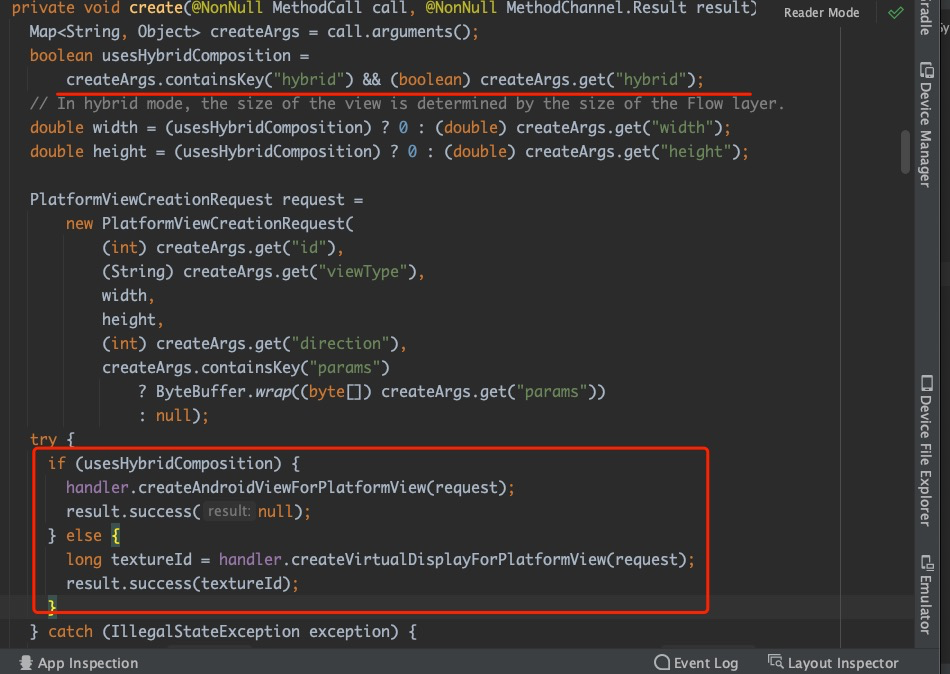
|
||
|
||
### 结论
|
||
|
||
所以可以看到,***hybrid composition* 保留了更多的原生控件效果,也节省了渲染成本** ,当然目前 `PlatformView` 还有一个比较尖锐的问题,例如 [#95343](https://github.com/flutter/flutter/issues/95343) 的闪动问题,这个问题看来在未来会通过更改渲染方式和纹理优化来解决。
|
||
|
||
是的,还是因为性能等问题,所以**新的 `PlatforView` 实现来又要来了,从上面提到的 [#31198](https://github.com/flutter/engine/pull/31198) 已经合并可以猜测,下一个稳定版本中,现在的 *virtual displayes* 实现将不复存在,进而替代的是通过新的 `TextureLayer` 实现,未来不排除 *hybrid composition* 也会被取消,不知道大家此刻心情如何?**
|
||
|
||
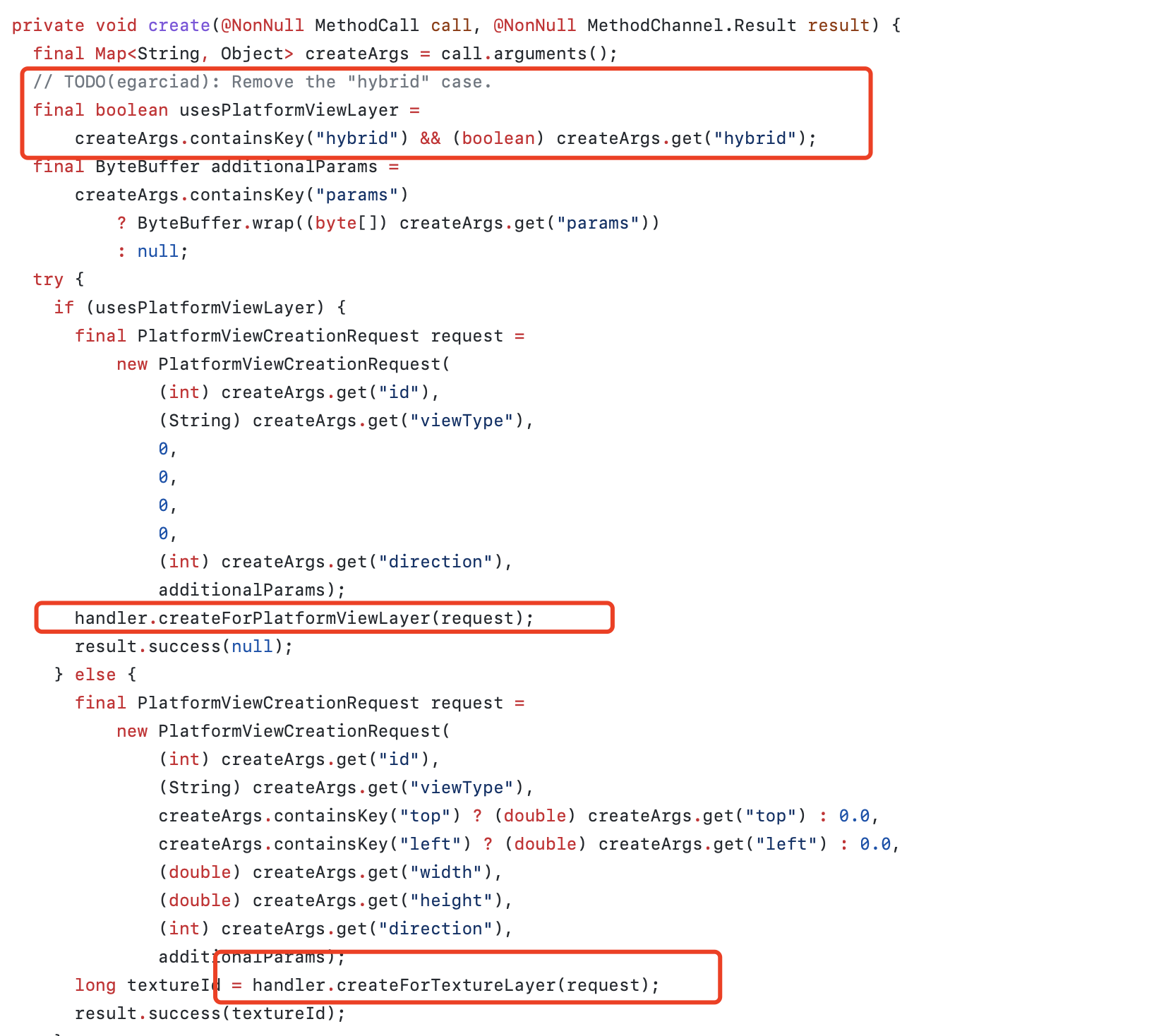
|
||
|
||
简单说就是:
|
||
|
||
- 新的 `PlatformViewWrapper` 会替换掉原本 *virtual display* 里 `SurfaceTextureWrapper` 相关的逻辑,通过对输入的 `Surface` 进行 `lockHardwareCanvas` 获取到 `Canvas` ,再通过 `super.draw(surfaceCanvas);` 进行绘制;
|
||
- 关于 *hybrid composition* 目前看起里仅是更换了称谓,只要核心逻辑没有大变动;
|
||
|
||
而如果未来 `PlatformViewWrapper` 的实现效果良好 ,可以猜测 *hybrid composition* 模式也会进而退出历史舞台,所以唯有感慨, Flutter 的技术演进速度真的好快。 |